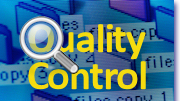European Broadcast Union calls for better integrated broadcast quality control

The European Broadcast Union (EBU) has set up a dedicated quality control (QC) group while holding a workshop on the subject in late June. The conclusion of the workshop was that although there are some good QC tools now, they are not well integrated and fail to provide the end-to-end automated solutions broadcasters and operators need to provide reliable multiscreen services. A lot more work is needed to help broadcasters make the transition to file-based delivery via IP infrastructures that introduce new links in the delivery chain where errors and bugs can be introduced. There need to be tools that pinpoint where errors are introduced and where it’s possible to automate corrective procedures so that the need for expensive human intervention is minimized.
QC vendors also need to recognize that monitoring and control system users often have little knowledge of file-based video delivery. They know a lot about traditional, tape-based A/V production, but very little about what can go wrong in files and which elements are important. QC tools therefore need to be easier to use and above all capable of integrating and assimilating the data in order to produce clear reports of problems. Indeed, the EBU calls for a new generation of tools that operates at the metadata level, combining data from a variety of existing probes and monitors, often from more than one vendor.
As the EBU noted, there is no shortage of QC products both for audio and video QC. However, they have mostly been engineered to have as large a feature set as possible for marketing purposes, with little regard for collaboration with other tools. So as a first step to improve interoperability, the EBU suggests defining common terminology for problems encountered in QC. Some tools, for example, seem to represent a large set of problems as blockiness, which may not be very helpful if you want to do a detailed analysis.
There is also need for agreement on a standardized reporting language or structure, perhaps based on XML, for delivering results and recommendations.
The EBU also suggested it may be a good idea for broadcasters to implement several tools in parallel collecting the same sort of data so that the results can be correlated in order to provide greater reliability and robustness in the analysis. It may be that one tool fails to highlight the seriousness of a problem, but that another one does.
The EBU’s new QC Group will help with these tasks, creating an overview of QC tools currently being offered and advising on best practices for broadcasters implementing QC in their facilities. The group also intends to produce files with QC test sequences, so broadcasters can check their systems. The EBU QC Group currently comprises about 60 industry representatives.
Get the TV Tech Newsletter
The professional video industry's #1 source for news, trends and product and tech information. Sign up below.
